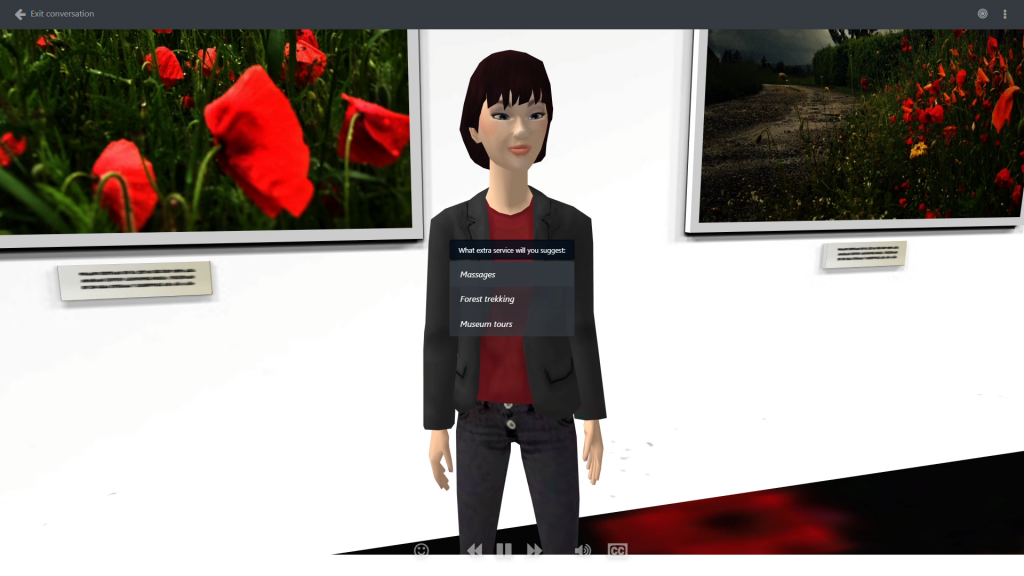In today’s fast-paced digital world, an online training platform has become essential for instructional designers, learning and development professionals, and e-learning agencies. These platforms offer various features and functionalities to facilitate distance education while catering to various learning styles.
This comprehensive guide will provide you with valuable insights into the world of online training platforms. We’ll begin by exploring their definition, benefits, and types available in the market. We’ll then investigate how to pick the most suitable platform for your business, depending on its requirements and objectives.
Additionally, we’ll delve into best practices for implementing an online training platform effectively within your organization. This includes establishing clear objectives, creating engaging content experiences, and leveraging automation tools and analytics.
Finally, we will share tips on optimizing your online training platform experience through gamification techniques, microlearning strategies, and interactive elements – all aimed at enhancing learner engagement. Moreover, we’ll also look at alternatives to traditional platforms, such as Udemy vs. Coursera comparison and other course creation options that are easily accessible in this ever-evolving digital landscape.
Table of Contents:
- What is an Online Training Platform?
- Definition of an Online Training Platform
- Benefits of Using an Online Training Platform
- Type of Online Training Platforms
- How to Choose the Right Online Training Platform for Your Business
- Best Practices for Implementing an Online Training Platform
- Tips for Optimizing Your Online Training Platform Experience
- Alternatives to Traditional Online Training Platforms
- Frequently Asked Questions Online Training Platform
- Conclusion
1. What is an Online Training Platform?
An online training platform is a digital solution that enables organizations to deliver, manage, and track educational content for employees or customers. Recent years have seen an increase in the popularity of online training platforms due to their ability to provide cost-effective and convenient learning opportunities.
Definition of an Online Training Platform
An online training platform, also known as a Learning Management System (LMS) or e-learning software, is a web-based application designed to administer, document, track, report, and deliver educational courses or training programs. These platforms allow users to access learning materials anywhere at any time through internet-connected devices such as computers, tablets or smartphones.
Benefits of Using an Online Training Platform
- Flexibility: Learners can access course materials on their schedule without being restricted by location or time constraints.
- Ease of use: Many online training platforms offer intuitive interfaces that make it easy for instructors and learners to navigate the system.
- Cutting costs: Businesses can save money on employee development initiatives by eliminating travel expenses and physical resources like textbooks and printed materials.
- Data-driven insights: Advanced analytics features within these platforms enable organizations to monitor learner progress effectively to identify areas where improvements are needed.
- Better retention rates: Engaging multimedia content with interactive elements promotes better knowledge retention than traditional methods like lectures alone.>
Type of Online Training Platforms
Different online training systems are available, all tailored to diverse needs and expectations. Some popular categories include:
- Course creation platforms: These tools, such as Udemy, allow users to create and sell their courses on various topics.
- E-learning programming solutions: Platforms like LearnBrite enable instructional designers and e-learning agencies to develop immersive 3D experiential learning scenarios without any coding knowledge required.
- Digital training platform for businesses: Solutions like Coursera SCORM cater specifically to organizations looking for an all-in-one solution that supports the development, delivery, tracking, and reporting of employee training programs.
To determine which online training platform best suits your organization’s unique needs, assessing your goals and desired outcomes is essential before comparing the features offered by different providers. The next section will discuss how to choose the right online training platform for your business in more detail.

An online training platform can provide a great way to deliver engaging, interactive learning experiences. Selecting the right platform for your training needs and objectives can be achieved by carefully considering certain criteria.
Key Takeaway:
A no-code platform is being developed to create engaging 3D learning scenarios for various types of online training, such as employee onboarding and gamified learning. The platform aims to provide immersive experiential learning that can be self-paced or instructor-led.
2. How to Choose the Right Online Training Platform for Your Business
Finding the perfect online training platform for your business can be daunting, especially with so many options available in today’s market. To make an informed decision and ensure you invest in a solution that meets your needs, consider these three crucial factors:
a) Assess Your Needs and Goals
Before diving into the world of online training platforms, it is essential to have a clear understanding of your organization’s learning objectives and requirements. This includes identifying the types of courses you want to offer (e.g., self-paced or instructor-led), specific features needed (such as SCORM compliance or gamification), and any technical constraints.
- Self-Paced vs. Instructor-Led Courses: Determine whether you need a platform that supports self-paced learning, where learners complete courses at their own pace or allows for live instructor-led sessions.
- Features & Functionality: List must-have features such as reporting tools, mobile compatibility, content authoring capabilities, etc., which will help narrow down potential platforms.
- Technical Constraints: Consider any limitations related to IT infrastructure or staff expertise when evaluating different solutions – some may require more advanced technical skills than others.
b) Consider Features and Functionality
The right digital training platform should meet your current needs and adapt as your business grows. Look out for these key features when comparing various online learning software platforms:
- User Experience: A user-friendly interface ensures smooth navigation and a positive learning experience for learners and administrators.
- Content Creation & Management: A platform offering built-in content authoring tools, or integration with third-party tools, will make creating engaging courses tailored to your audience easier.
- Assessment & Tracking: Comprehensive reporting capabilities allow you to track learner progress, measure training programs’ effectiveness, and identify improvement areas.
c) Evaluate Ease of Use and Cost
The ideal online training platform should be easy to use while offering value for money. Keep these factors in mind when comparing different solutions:
- Ease of Use: Opt for a solution that is intuitive and requires minimal technical expertise – this will save time on staff training and ensure quick adoption by users.
- Budget Constraints: Determine your budget beforehand so you can focus on platforms within your price range. Remember that cheaper options may not always provide the best value regarding features or support services.
- Total Cost of Ownership (TCO): Consider any additional costs associated with implementation, customization, maintenance fees or upgrades when calculating TCO over time – some platforms may appear more affordable upfront but cost more in the long run due to hidden expenses.
Considering these factors will help you choose an online training platform that aligns with your business objectives while providing a seamless learning experience for employees. For example, LearnBrite’s no-code platform allows businesses to create immersive 3D experiential learning scenarios without any coding knowledge required.

Deciding on your enterprise’s ideal virtual learning platform requires attentively evaluating what you require and wish to accomplish, its capacities and usability, and the price. With these best practices, you can successfully implement an effective online training platform to meet your organizational objectives.
From immersive learning initiatives to always-on events, LearnBrite allows you to run evergreen experiences that delight attendees and generate sponsor leads on autopilot. Your Metaverse becomes a hub of engaging and interactive experiences that continue to captivate and inspire, providing continuous value and driving attendee engagement and sponsor opportunities without constant manual effort.
With LearnBrite, you can seamlessly integrate with enterprise Single Sign-On (SSO) authentication, ensuring robust data privacy and security at bank-level standards. Your Metaverse is protected, adhering to governmental standards such as GDPR (General Data Protection Regulation), providing peace of mind and compliance with your organization’s data privacy requirements.
Key Takeaway:
A no-code platform is being developed to create immersive 3D learning scenarios for online training. This platform can be used for various purposes, such as micro-learning modules, employee onboarding, and gamified learning.
3. Best Practices for Implementing an Online Training Platform
To ensure the success of your online training platform and maximize its benefits, it is essential to follow best practices. In this section, we’ll explore key strategies to help you make the most out of your chosen platform.
Establish Clear Objectives and Goals
The first step in implementing an online training platform is setting clear objectives and goals for what you want to achieve with it. These should align with your overall business strategy and address specific needs, employee knowledge, or skills gaps. By establishing measurable targets, such as increasing course completion rates or improving performance on assessments, you can better evaluate the effectiveness of your digital training efforts.
SMART criteria
- Specific: Clearly define what learners need to know or do after completing the course.
- Measurable: Determine how progress towards achieving objectives will be tracked.
- Achievable: Ensure that learning goals are realistic, given available resources and time constraints.
- Relevant: Align objectives with broader organizational goals and learner needs.
- Time-bound: Set deadlines for when learners should achieve learning outcomes.
Create Engaging Content and Experiences
To ensure learners remain captivated throughout their online training, it is essential to crafting content that is both informative and enjoyable. This may involve incorporating multimedia elements like videos, interactive quizzes, simulations, role-plays or even immersive experiences using platforms like LearnBrite, which offers a no-code solution for creating experiential learning scenarios in a 3D environment. By offering a variety of content formats, you can cater to different learning styles and preferences, ensuring that your training materials resonate with all employees.
LearnBrite
LearnBrite is an innovative online training platform that allows instructional designers and e-learning agencies to create immersive 3D experiences for self-paced or instructor-led courses, microlearning modules, employee onboarding programs, soft skills training sessions and more – all without the need for coding knowledge.
Utilize Automation Tools and Analytics
Leveraging automation tools within your online training platform can save time by streamlining administrative tasks such as enrollment management or course assignment. Additionally, using analytics features can provide valuable insights into learner progress and performance, which can help identify areas where additional support may be needed or inform future content development efforts. For example:
- Track completion rates: Monitor how many learners have completed each module or course to gauge overall engagement levels.
- Analyze assessment results: Identify trends in test scores across various topics to pinpoint areas for improvement.
- Evaluate feedback: Collect qualitative data from surveys or discussion forums to better understand learner perceptions of the course material and make adjustments accordingly.
By following these best practices when implementing an online training platform like LearnBrite, you’ll set yourself up for success while providing engaging learning experiences that drive meaningful outcomes for your organization and its employees.
Implementing the recommended methods can guarantee your e-learning system will be optimized for success. Moving forward, we will explore tips and strategies further to enhance the user experience of an online training platform.
Key Takeaway:
A no-code platform is being developed to create engaging 3D learning experiences for various types of training, such as onboarding and soft skills development. This online training platform aims to provide immersive simulations that can be used in self-paced or instructor-led courses, micro-learning modules, gamified learning and more.
4. Tips for Optimizing Your Online Training Platform Experience
To maximize the use of your virtual training platform, enhancing student and educator experiences is essential. This can be achieved by leveraging gamification techniques, incorporating microlearning strategies, and utilizing interactive course elements.
Leverage Gamification Techniques
A gamification is a powerful tool that can significantly enhance learner engagement and motivation. Integrating game mechanics such as points, badges, leaderboards, and challenges into your course, content allows you to create an enjoyable learning environment that encourages users to participate in their education actively. Some popular gamified platforms include Kahoot., Classcraft, and EduFlow.
Online learning platforms, along with online education, provide a wide range of online courses, making learning online accessible through online platforms for a seamless educational experience.
Incorporate Microlearning Strategies
Microlearning involves breaking down complex topics into smaller chunks of information that are easier for learners to digest. This approach improves knowledge retention and allows users to progress at their own pace without feeling overwhelmed by lengthy lessons or modules. To implement microlearning effectively:
- Create bite-sized content (5-10 minutes long) focused on specific objectives or skills.
- Use multimedia formats like videos, infographics, quizzes or podcasts.
- Ensure each piece of content stands alone so learners can access them independently according to their needs.
Platforms like TalentCards and Lessonly specialize in microlearning content creation and delivery.
Utilize Interactive Elements
Incorporating interactive elements into your online training platform can significantly boost learner engagement, as it encourages active participation rather than passive consumption of information. Some examples of interactive components include:
- Quizzes and assessments: Test learners’ knowledge throughout the course to reinforce learning objectives and provide feedback on their progress.
- Social features: Enable users to interact with each other through discussion boards, group projects or peer reviews to foster collaboration and build a sense of community within the platform.
- User-generated content: Encourage learners to create resources (e.g., blog posts, videos) that contribute to the overall course material while demonstrating mastery of specific topics or skills.
To maximize the effectiveness of your online training, utilize optimization techniques to ensure that it meets both business objectives and learner needs. Don’t forget to continually monitor user feedback and analytics data to make informed decisions about further improvements.

By utilizing gamification techniques, incorporating microlearning strategies and implementing interactive elements into your online training platform experience, you can optimize the learning process for your users. Alternatives to traditional online training platforms include Udemy vs. Coursera vs. other course creation platforms, digital learning software solutions and web-based training solutions, which offer a wide range of options for providing effective eLearning experiences.
Key Takeaway:
A no-code platform is being developed to create immersive 3D learning scenarios for various training purposes, such as employee onboarding, soft skills development, and gamified learning. The platform aims to provide self-paced or instructor-led courses with role-play simulations and micro-learning modules in an engaging manner.
5. Alternatives to Traditional Online Training Platforms
Staying abreast of the latest alternatives to traditional online training platforms is essential for e-learning professionals. As you explore options beyond traditional learning management systems (LMS), consider these popular course creation platforms, digital learning software solutions, and web-based training tools.
Udemy vs. Coursera vs. Other Course Creation Platforms
Udemy and Coursera are two well-known course-creation platforms that offer a wide range of educational content for learners across various industries. However, there are other noteworthy alternatives available:
- No-code platform LearnBrite: This innovative solution allows instructional designers and e-learning agencies to create immersive 3D experiential learning scenarios without any coding knowledge required. Ideal for self-paced or instructor-led courses, microlearning modules, employee onboarding programs, soft skills training sessions, gamified lessons or role-play simulations.
- TalentLMS: A versatile LMS designed for businesses looking to deliver effective online training through an easy-to-use interface that supports multimedia content integration.
- Kajabi: An all-in-one platform tailored towards entrepreneurs who want to build their courses while managing marketing efforts within one system.
Digital Learning Software Solutions
Beyond typical course creation platforms like Udemy or Coursera SCORM-compliant offerings exist, numerous digital learning software solutions to enhance user engagement and knowledge retention. Some popular options include:
- Articulate Storyline: A powerful e-learning programming tool that enables instructional designers to create interactive, media-rich courses for various devices.
- Gomo Learning: A cloud-based authoring platform designed for creating responsive HTML5 content accessible on any device, making it an ideal choice for mobile learning experiences.
- Raptivity: An online training software solution offering a library of customizable templates and interactions to help build engaging course content quickly and efficiently.
Distance education, with its self-paced learning and a wide range of educational tools, including discussion boards and digital channels, has become increasingly popular, offering skills needed for computer science, data science, and software development and connecting students through platforms like Google Classroom, ispring suite, ispring learn, Microsoft Teams, and Blackboard Learn, making education easily accessible in the era of blended learning and cloud computing on digital channels.
Web-Based Training Solutions
In addition to the platforms above, web-based training solutions can provide businesses with flexible alternatives when implementing their online learning programs. These tools often require minimal setup or installation while delivering robust features and functionality. Examples of such solutions are as follows:
- Skillsoft Percipio: An intelligent learning experience platform providing access to thousands of curated resources, including videos, books, audiobooks, articles and more, in a user-friendly interface tailored towards self-directed learners.
- Absorb LMS: An award-winning web-based training platform known for its intuitive design and powerful analytics capabilities that make tracking learner progress simple yet effective…..
Key Takeaway:
A no-code platform is being developed to create engaging 3D learning experiences for various training purposes, such as employee onboarding, soft skills development and gamified learning. The online training platform aims to provide immersive scenarios that can be used in self-paced or instructor-led courses, micro-learning modules, role-play simulations and more.
Frequently Asked Questions Online Training Platform
What is the purpose of an online training platform?
The primary purpose of an online training platform is to facilitate efficient and effective learning experiences for individuals or organizations. These platforms provide a centralized location for creating, managing, and delivering educational content while offering various features such as progress tracking, assessment tools, collaboration capabilities, and analytics to enhance the learning experience.
Conclusion
In conclusion, online training platforms offer many advantages for businesses creating and delivering digital learning experiences. By selecting the right platform that meets your needs and following best practices for implementation, you can ensure an optimized experience for learners. While traditional online training platforms are popular options, alternatives are available if they don’t meet your requirements. With careful consideration and planning, any business can benefit from an effective online training platform.
Make your Metaverse future-proof with LearnBrite‘s browser-based platform, allowing seamless access across smartphones, tablets, laptops, and VR/AR headsets without downloading or installing software. Empower users to explore and experience your Metaverse effortlessly, ensuring maximum accessibility and convenience.


.png)
Recent Comments